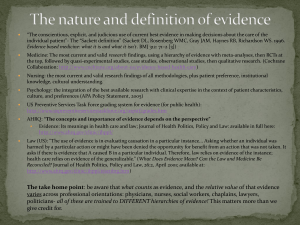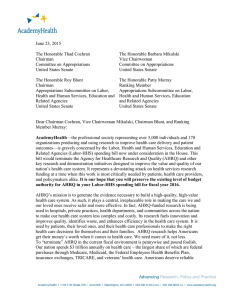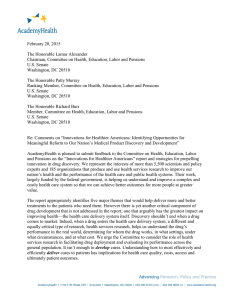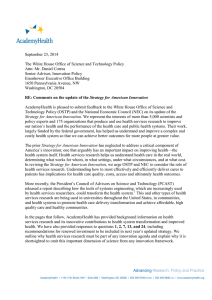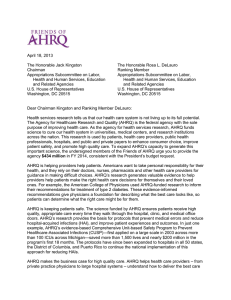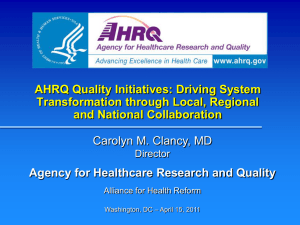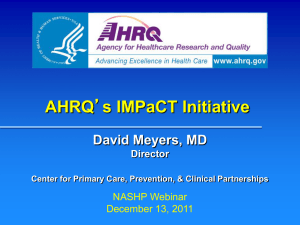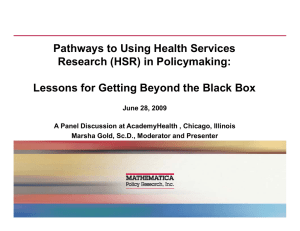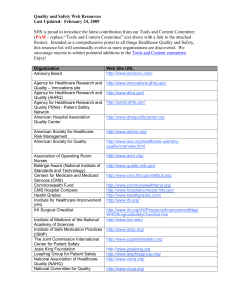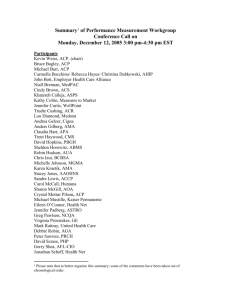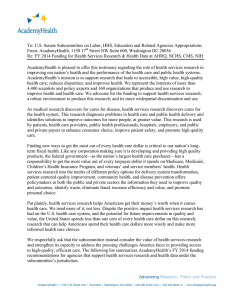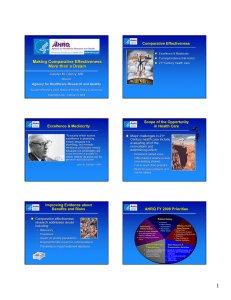To: U.S. Senate Committee on Appropriations
advertisement
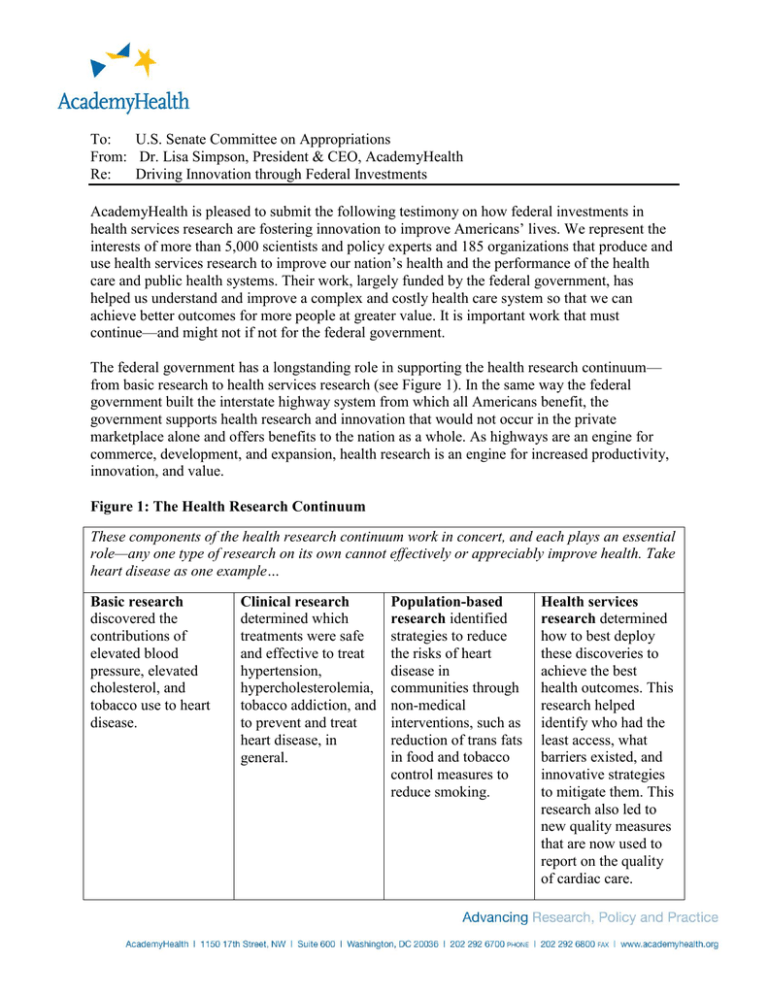
To: U.S. Senate Committee on Appropriations From: Dr. Lisa Simpson, President & CEO, AcademyHealth Re: Driving Innovation through Federal Investments AcademyHealth is pleased to submit the following testimony on how federal investments in health services research are fostering innovation to improve Americans’ lives. We represent the interests of more than 5,000 scientists and policy experts and 185 organizations that produce and use health services research to improve our nation’s health and the performance of the health care and public health systems. Their work, largely funded by the federal government, has helped us understand and improve a complex and costly health care system so that we can achieve better outcomes for more people at greater value. It is important work that must continue—and might not if not for the federal government. The federal government has a longstanding role in supporting the health research continuum— from basic research to health services research (see Figure 1). In the same way the federal government built the interstate highway system from which all Americans benefit, the government supports health research and innovation that would not occur in the private marketplace alone and offers benefits to the nation as a whole. As highways are an engine for commerce, development, and expansion, health research is an engine for increased productivity, innovation, and value. Figure 1: The Health Research Continuum These components of the health research continuum work in concert, and each plays an essential role—any one type of research on its own cannot effectively or appreciably improve health. Take heart disease as one example… Basic research discovered the contributions of elevated blood pressure, elevated cholesterol, and tobacco use to heart disease. Clinical research determined which treatments were safe and effective to treat hypertension, hypercholesterolemia, tobacco addiction, and to prevent and treat heart disease, in general. Population-based research identified strategies to reduce the risks of heart disease in communities through non-medical interventions, such as reduction of trans fats in food and tobacco control measures to reduce smoking. Health services research determined how to best deploy these discoveries to achieve the best health outcomes. This research helped identify who had the least access, what barriers existed, and innovative strategies to mitigate them. This research also led to new quality measures that are now used to report on the quality of cardiac care. Source: AHRQ: 15 Years of Transforming Care and Improving Health, AcademyHealth, Jan. 2014. Available at: http://academyhealth.org/files/AHRQReport2014.pdf The United States spent $2.8 trillion—17.2 percent of our economy—on health care in 2012. Health services research has shown we waste as much as 30 percent of what we spend on health care on unnecessary services, inefficiently delivered services, and missed opportunities for prevention.i Finding new ways to get the most out of every health care dollar is critical to our nation’s long-term fiscal health, and health services research is our nation’s research and development, or ‘R&D,’ enterprise for such innovations. While medical research discovers cures for disease, health services research discovers innovative cures for the health system. This research diagnoses problems in health care and public health delivery and identifies solutions (see Figure 2). Innovations from health services research can be used right now by patients, health care providers, public health professionals, hospitals, employers, and public and private payers to improve care today. Figure 2: Contributions of Health Services Research to Quality Improvement Thanks to health services research, we know that health care sometimes falls short… An estimated 1.7 million hospital-acquired infections occur each year, leading to about 100,000 deaths.ii Patients do not receive the care recommended for them by evidence. For example, patients with diabetes receive recommended preventive care only 21 percent of the time. Health care is increasingly complex and for patients with multiple chronic conditions, poor coordination results in unnecessary tests, hospitalization, and readmissions. One study found that almost one-fifth of Medicare patients were re-hospitalized within 30 days.iii Thanks to health services research, we know that falling short costs money… In 2008, costs attributable to medical errors were estimated at $19.5 billion—more than half of the National Institutes of Health’s annual budget.iv Medication errors alone cost as much as $2 billion each year—equivalent to the federal annual investment in health services research.v The average cost of care for a patient with a catheter-related blood stream infection is $45,000, costing up to $2.3 billion annually nationwide.vi Medicare spends $12 billion a year on preventable hospital readmissions—more than double the discretionary budget of the Centers for Disease Control and Prevention.vii Thanks to health services research, we have identified innovations that work… Reporting on the quality of care in hospitals leads to decreased patient mortality and reporting on nursing home quality shows improvements in pain management, reductions in pressure ulcers, and improved patient and family satisfaction.viii Implementation of computerized physician order entry could prevent between 570,000 and 907,000 serious medication errors each year.ix Quality improvement approaches, including improved primary care, discharge planning, and follow-up care can prevent or reduce hospitalizations and rehospitalizations.x One area in which health services research has led to significant reductions in loss of life and health care spending is in patient safety. For example, in response to a high rate of central lineassociated bloodstream infections (CLASBIs) at Johns Hopkins Hospital in Baltimore, Maryland, Dr. Peter Pronovost and his team developed an innovative program that included a checklist of best practices—a protocol he named the Comprehensive Unit-Based Safety Program or CUSP. CUSP combines clinical best practices with an understanding of the science of safety and improves the culture where clinician teams are accountable for results. The program asked clinicians to review their infection rates and investigate every infection to learn how it could have been prevented. In a short time, the hospital virtually eliminated these infections. In 2003, with funding from the Agency for Healthcare Research and Quality (AHRQ)—the only federal agency with the sole purpose of generating and disseminating health services research— Dr. Pronovost partnered with the Michigan Health and Hospital Association to see if the success of his innovation at Johns Hopkins could be replicated elsewhere. Within six months, CLABSIs were reduced by 66 percent in more than 100 Michigan ICUs. By the experiment’s end, 65 percent of Michigan ICUs went a full year without an infection. With continued support from AHRQ and leadership from the American Hospital Association and many state hospital associations, the program has spread state-by-state to more than 1,100 hospitals. The program saved more than 1,500 lives and nearly $200 million in its first 18 months just in Michigan, “all from just an initial $500,000 investment from AHRQ,” according to Dr. Pronovost. Federal investments in AHRQ and health services research have created a wealth of knowledge about other areas of our health care delivery system, as well. For example, health services research has informed the development of best practices for the treatment of various diseases and conditions to ensure patients get the right care at the right time, every time. Dr. David Penson of Vanderbilt University Medical Center used funding from AHRQ not to find the newest drug for the treatment of prostate cancer, but to maximize outcomes using the treatments already available and to get information about what works to patients and providers so they can make better decisions. His focus on innovation is to bring health services research to the frontiers of personalized health decision-making in cancer treatment, where a patient can go to a website, type in demographic data, and see the likely outcomes for a range of treatments for their demographic. Such innovative tools will allow for patients to participate as informed parties in their health care decisions. Dr. Brent James and Dr. Lucy Savitz of Intermountain Healthcare—a nationally recognized nonprofit health system serving patients in Utah and southern Idaho—used federal funding from AHRQ to create and disseminate scientific evidence about what works in care delivery and research diffusion. For example, in a study on cystic fibrosis quality improvement and management, Dr. James and Dr. Savitz found that consistent execution of health care models could double the life expectancy in their patients. In another AHRQ-funded grant, an Intermountain-based researcher, Dr. Flory Nkoy, developed a tool to prevent hospital readmissions of children with asthma. The tool tracks peak flow, showing degradation before an attack and allowing physicians to intervene before the child needs to go the hospital. Keeping children out of the hospital improves their health outcomes, and helps drive down health care costs. “We’ve found it’s highly effective, and we believe it will become even more useful when the tool is used in adults,” said Dr. Savitz. “This is the goal of AHRQ funding—to fund one project that leads to significant advances in other areas.” Put plainly, health services research helps Americans get their money’s worth when it comes to health care. Innovations in health care delivery benefit patients in concrete terms – better outcomes, better information for decision-making and lower costs. The health care value found through minimal investments in health services research are the key to lowering national health care spending as well, which will contribute to deficit and debt reduction. Our nation’s scientific enterprise has borne its fair share of responsibility for deficit reduction. It’s now time to address our nation’s innovation deficit. The sooner we invest in the generation and dissemination of health services research, the sooner we get to reap the rewards of lower health costs and higher quality care. i Institute of Medicine, Best Care at Lower Cost: The Path to Continuously Learning Health Care in America. September 2012. www.iom.edu/Reports/2012/Best-Care-at-Lower-Cost-The-Path-to-Continuously-LearningHealth-Care-in-America.aspx ii Thomas EJ, Studdert DM, HR B, et al. Incidence and types of adverse events and negligent care in Utah and Colorado. Med Care 2000; 38:261-71 iii Institute of Medicine, Best Care at Lower Cost: The Path to Continuously Learning Health Care in America. September 2012. www.iom.edu/Reports/2012/Best-Care-at-Lower-Cost-The-Path-to-Continuously-LearningHealth-Care-in-America.aspx iv 2010 National Healthcare Quality Report, U.S. Department of Health and Human Services, Agency for Healthcare Research and Quality, Publication No. 11-0004, p. 135. March 2011. See also: www.ahrq.gov/qual/qrdr10.htm v The Leapfrog Group FACT SHEET, Computerized Physician Order Entry. April 2008 vi Pronovost P et al. An intervention to decrease catheter-related bloodstream infections in the ICU. New England Journal of Medicine. Dec. 2006. Pp. 2725-32.; and O’Grady NP, et al. Guidelines for the prevention of intravascular catheter-related infections. Centers for Disease Control and Prevention. MMWR Recommendations and Reports. 51 2002:1-29. vii Report to Congress: Promoting Greater Efficiency in Medicare. MEDPAC. June 2007. Ch. 5, p 108. viii Totten AM, Wagner J, Tiwari A, et al. Public Reporting as a Quality Improvement Strategy. Closing the Quality Gap: Revisiting the State of the Science. Evidence Report/Technology Assessment No. 208. (Prepared by the Oregon Evidence-Based Practice Center) AHRQ Publication No. 12-E011-EF. Rockville, MD: Agency for Healthcare Research and Quality. July 2012. www.effectivehealthcare.ahrq.gov/reports/final.cfm. ix Birkmeyer JD, et al. Leapfrog patient safety standards: the potential benefits of universal adoption. Washington, DC: The LeapFrog Group; 2000. x The Commonwealth Fund Commission on a High Performance Health System, Why Not the Best: Results from the National Scorecard on U.S. Health System Performance, 2008, The Commonwealth Fund, July 2008
